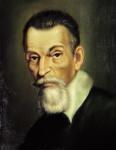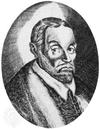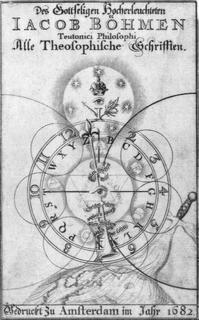The 17th century was a period of pervasive upheaval, which violently shook the very foundations of the world in all realms of life. It was a time when alchemy and empirical science easily coexisted, a time when the exploration of new worlds and the investigation of the sky challenged traditional conceptions of the place of earth in the universe, a time of religious persecution and political conflict - a time not that different from today. And like tumultuous periods throughout history it was also a time that produced some of our most treasured art, architecture, poetry, and music.
 In the first decade of the 17th century Monteverdi wrote that he intended to publish a treatise describing the 'secunda pratica' or ‘second practice,’ the new compositional attitude that he and his colleagues had adopted. Drawing on Plato, he said that his book would be laid out in three parts and would begin with a chapter on oration. How appropriate that a manifesto of the new music of the 17th century should give such prominence to the rhetorical art, for the communication of words and the emotions they express was the dominant motivation driving composers of the period. Through the experiments that led to the creation of the genres of opera, oratorio, and cantata, composers sought to integrate drama and music into new compositional approaches that reflected the immediacy and engagement so essential to the art of oratory.
In the first decade of the 17th century Monteverdi wrote that he intended to publish a treatise describing the 'secunda pratica' or ‘second practice,’ the new compositional attitude that he and his colleagues had adopted. Drawing on Plato, he said that his book would be laid out in three parts and would begin with a chapter on oration. How appropriate that a manifesto of the new music of the 17th century should give such prominence to the rhetorical art, for the communication of words and the emotions they express was the dominant motivation driving composers of the period. Through the experiments that led to the creation of the genres of opera, oratorio, and cantata, composers sought to integrate drama and music into new compositional approaches that reflected the immediacy and engagement so essential to the art of oratory.Perhaps because the fruits of these experiments remain fundamental to musical perception three centuries later, they take on a special significance for us. The basic elements of what we now call “common practice” tonality, the dominance of the keyboard as the basis of musical conception, the emergence of institutions like orchestras and opera companies and the appearance of professional virtuoso performers – the very notion that the purpose of music was to move the passions and communicate emotions – all this developed in the seventeenth century. I would argue that beyond a mere curiosity about the origins of our current musical universe, the music of the seventeenth century has a special resonance for us today because we also are living through a 'paradigm shift' comparable to the crises of the seventeenth century, with all the attendant upheaval characteristic of such times.
The culture of late 16th century Italy was marked by sharp philosophical contrasts and an eclectic intellectual climate. Historians typically portray this culture as a confrontation of conflicting intellectual, spiritual and social forces: classical versus Christian tradition, totalitarianism versus republicanism, feudalism versus capitalism, logic versus rhetoric, mysticism versus scientific rationalism. Certainly the turn of the seventeenth century was no worse than any other time – wars, famine, recessions, epidemics and religious controversies were not inventions of the seventeenth century. Nevertheless the constant political and economic insecurity of the 16th century had succeeded in shaking the self-confidence of Renaissance society to such a degree that awareness of a sense inescapable crisis, of the absurdity of human endeavor, could effectively replace his faith in the creative forces of man as a rational creature.
Just as powerfully, the effect of the Protestant Reformation and the subsequent Catholic reaction had shattered any sense of spiritual universality (though this was always a myth in any case). Religious denomination became a favorite pre-text in power politics, the most horrific example being the Thirty Years War that dominated the lives of most of Europe for the first half of the 17th century.
The human species’ place at the center of the universe had been challenged by discoveries of Copernicus and especially by Galileo’s experiments with telescopes. Though it would not be until the 18th century that a conception of the Earth as a speck lost in an infinite universe would be widely accepted, doubt nevertheless prevailed about the accepted Aristotelian cosmology despite the draconian efforts of the Church to maintain it.
In his influential book Monteverdi and the End of the Renaissance, Gary Tomlinson focuses on the dichotomy between scholasticism and humanism in charting the development of Monteverdi’s music and his observations tell us a great deal about the fundamental shift in the attitudes of artists, musicians, and poets of the period and the new techniques and genres of expression that they created. This struggle between authority and innovation can serve as a useful window into the artistic climate of the time that highlights the role of oratory and rhetoric in stimulating its artistic expression.
Scholasticism arouse in the universities of the Middle Ages and was closely associated with the teaching there of theology, philosophy, medicine and law. It was characterized by a reliance on authority in the form of Scripture and Classical texts and a faith in the absolute truth of knowledge gained through rigorous deductive logic.
Aristotle in particular appeared to present a systematic exploration of the full potential of human reason itself. Many scholastic writers were confident that complete knowledge was attainable and indeed already had been attained by a few ancient and early Christian writers in their fields of expertise. It can be said that the scholastic vision assumed not only the existence of a universal order but also a substantial capacity of the human mind to grasp this order. The appeal of such a attitude is of course its fundamentally optimistic view of man’s intellectual capabilities and the fact that it reinforced the unity, perfection and authority of an omnipotent God.
However, if reality was closed, systematically ordered, and completely apprehensible as the scholastics believed, then knowledge itself must be limited. Accepting the authority of the ancients could ultimately entail rejecting the possibility of new ideas. Though it may be easy to dismiss the “Schoolmen” as hopelessly old fashioned, their arguments have much in common with the influential arguments of various fundamentalists of our own day. At any rate, facing the geographical, cosmological, technological, and other discoveries of the sixteenth century, the scholastic deference to authority sometimes hardened into dogmatism – a dogmatism that stimulated important questions about scientific, scholarly, and artistic innovation.
Humanism, by contrast, was native to Italy – a response to the imported scholastic ideas that seems to have been nurtured by the circumstances of Italian urban life. The necessities of business and self-governance encouraged a pragmatic view of the uses and ends of knowledge – learning was applied to everyday concerns and human actions, foreign to scholastic thinkers. A whole class of educated men emerged who were employed to work out contracts and negotiate with foreign traders and man the government bureaucracies. Soon a new breed of scholars, referred to as humanisti, appeared. They stressed moral philosophy and teachings derived from poetry and above all history. The humanisti promoted a new dialectic that blurred the distinction between scientific demonstration and plausible argumentation, marking a shift from syllogistic to topical logic.
In this new view, human will attained a centrality and importance that was at odds with its scholastic position as merely a mediator between reason and passion.
Petrarch, one of the first humanists, wrote that “It is safer to strive for the good and pious will, than for a capable and clear intellect. The object of the will is to be good; that of the intellect is truth. It is better to will the good than to know the truth.”
The Humanists esteem for man’s will and their pragmatic view of knowledge arose in interaction with the requisites of republican self-governance and commercial necessity. Through the will, more than the intellect, man’s passions could be swayed and channeled to result in right action. The importance of rhetorical persuasion to this new vision is obvious.
Behind the humanistic exaltation of oratory lay a recognition of the passions as dynamic forces directing human actions and thought and a need to control and exploit these forces. The humanist had little faith in the encompassing theories of the ancients, recognizing instead the validity of practical experience and accepting its fragmentary and unsystematic nature as the inevitable impression of a complex reality on the imperfect human intellect.
This humanist perception of reality encouraged a reconsideration of the relationships among the intellectual disciplines and the consideration of their differing methods and goals. Natural philosophy or science was seen by the scholastics as governed by universal laws and they distinguished their discipline, characterized by its logical search for universal truth, from the lower disciplines like astronomy, which merely observed phenomena. But in the face of ever more exact and diverse empirical observation humanists tended to admit their meager understanding of the laws of nature and came to a healthy realization of the limitations of classical authority. The unpredictable actions of man, ruled as often by his passions as by his intellect, became the focus of their study. So how did this opposition of humanism and scholasticism play out in music?
 In the first decade of the 17th century a controversy has been preserved in an exchange of published letters between a Bolognese academic named Giovanni Maria Artusi, often under the guise of the pseudonym Bracchino da Todi (they were gentlemen after all) and Monteverdi. Monteverdi figures so prominently not only because he was arguably the most celebrated musician of the time but also because we are fortunate to have so much of his correspondence – so many of the composers of the 17th century left little beyond their music for our consideration. He also serves admirably as a representative of the new music of the 17th century. He was by no means a radical like Peri or Caccini or Galileo’s father Vincenzo. Rather he was a synthesizer, taking the avant-garde techniques of the time and fashioning it into powerful enduring masterpieces that exerted a profound influence on all who followed.
In the first decade of the 17th century a controversy has been preserved in an exchange of published letters between a Bolognese academic named Giovanni Maria Artusi, often under the guise of the pseudonym Bracchino da Todi (they were gentlemen after all) and Monteverdi. Monteverdi figures so prominently not only because he was arguably the most celebrated musician of the time but also because we are fortunate to have so much of his correspondence – so many of the composers of the 17th century left little beyond their music for our consideration. He also serves admirably as a representative of the new music of the 17th century. He was by no means a radical like Peri or Caccini or Galileo’s father Vincenzo. Rather he was a synthesizer, taking the avant-garde techniques of the time and fashioning it into powerful enduring masterpieces that exerted a profound influence on all who followed. Artusi objected to certain contrapuntal practices he had observed in some as yet unpublished madrigals of Monteverdi, noting that they violated the rules of correct composition as laid down in the magisterial treatise of Zarlino in 1555 that was widely accepted as the authority on musical composition. Monteverdi eventually responded in the preface to one of his madrigal collections that was later expanded by his brother, Giulio Cesare. Essentially Monteverdi couldn’t really be bothered to engage with a pedant like Artusi but felt he must make some defense of new musical practices, which he saw as already well established by that time. It is here that he promised his treatise on the seconda prattica, or second practice, second as in following chronologically not as superior to or superceding the older or ‘prima prattica".
This new practice is not based on a compositional principle or a new set of rules but rather on a new attitude toward the respective roles of text and music. For thinkers like Artusi, the intellect and not the feelings were the last resort when judging a work of art. Monteverdi, however, perceived the goal of music as being an appeal to the emotions of the audience, not to their understanding and in attaining this goal, music was justified in using any means, even if it infringed on the established rules. For Artusi ‘art’ meant artistic skill, a craft at the highest level, constrained by a theory, which established its rules and thus made it teachable and learnable, debatable and controllable. For Monetverdi art began where it stopped for Artusi. The ingenious idea, the non-verifiable, the non-teachable, the step past the boundaries of instruction, was the essence of art – based, significantly on an otherwise compulsory set of rules, so that a transgression against them could be recognized as such. For Monteverdi a work of art distinguished itself by the very fact that it could not be completely understood, that it possessed something disconcerting, mysterious and not entirely explicable. Within this idea of the seconda prattica are found the origins of the later aesthetic theory of genius in which the genius breaks the shackles of tradition and creates his own rules.
Fundamental to Monteverdi’s rebuttal of Artusi is his claim that words should be the ‘mistress’ of the music and not the other way around. Later defenders of this new attitude sited with disdain composers who could write whole compositions of perfect counterpoint and afterward hang on the notes whatever words would fit. For a musician of humanist leanings like Monteverdi, the expressive power of music was a function of its relation to its text.
The highest goal that music could seek was to form a syntactic and semantic union with its text so perfect that the distinction of musical and nonmusical elements seemed to fade before the heightened oratorical power of a single musical speech. “To speak through singing...”
In its specifics, the dispute between Artusi and Monteverdi was over fairly minor compositonal procedures that strike us as arcane and inconsequential. Its importance lies in the insights it offers into the changing attitude to authority so characteristic of the period. Artusi grounded an optimistic view of the capabilities of human intellect in the comprehension of an unchanging natural order. He, and others like him, could not admit a universe so disconcerting that the sun itself had stopped moving and the earth had taken its place.
Monteverdi, as a representative of humanist inclinations among musicians of his time, understood that the artistic authorities of the past were conditioned by their own cultures to express themselves in ways not necessarily relevant to the present – he rejected the scholastic placing of theory over practice. Perhaps most importantly, Monteverdi’s concern for the joining of music to poetry in a single moving and persuasive language links him to the humanist’s high estimation of man’s will and their urge to sway the passions, associating him with the humanist’s pursuit of rhetorical eloquence, the key to those passions.
[1] This article, which originated as a lecture at the University Club in San Francisco in September, 2004, benefits substantially from several scholarly works. Due to its nature as an unpublished lecture for a general audience, I was not scrupulous about specific citations. I hope that a general citation in the following bibliography will convey my recognition of the role of the works cited in informing this article and excuse me for any unintentionally uncited quotes.
***********
Select Bibliography
Arnold, Denis and Fortune, Nigel. The Monteverdi Companion. New York, 1968.
Bianconi, Lorenzo. Music in the Seventeenth Century. Turin, 1982.
Brouwsma, William. The Waning of the Renaissance. New Haven and London, 2000.
Kuhn, Thomas. The Copernican Revolution. Cambridge and London, 1957.
Kuhn, Thomas. The Structure of Scientific Revolutions. Chicago, 1962.
Tomlinson, Gary. Monteverdi and the End of the Renaissance. Berkeley, 1987.





